Accuracy of gastrocnemius muscles forces in walking and running goats predicted by one-element and two-element Hill-type models
- PMID: 23871235
- PMCID: PMC4339187
- DOI: 10.1016/j.jbiomech.2013.06.001
Accuracy of gastrocnemius muscles forces in walking and running goats predicted by one-element and two-element Hill-type models
Abstract
Hill-type models are commonly used to estimate muscle forces during human and animal movement-yet the accuracy of the forces estimated during walking, running, and other tasks remains largely unknown. Further, most Hill-type models assume a single contractile element, despite evidence that faster and slower motor units, which have different activation-deactivation dynamics, may be independently or collectively excited. This study evaluated a novel, two-element Hill-type model with "differential" activation of fast and slow contractile elements. Model performance was assessed using a comprehensive data set (including measures of EMG intensity, fascicle length, and tendon force) collected from the gastrocnemius muscles of goats during locomotor experiments. Muscle forces predicted by the new two-element model were compared to the forces estimated using traditional one-element models and to the forces measured in vivo using tendon buckle transducers. Overall, the two-element model resulted in the best predictions of in vivo gastrocnemius force. The coefficient of determination, r(2), was up to 26.9% higher and the root mean square error, RMSE, was up to 37.4% lower for the two-element model than for the one-element models tested. All models captured salient features of the measured muscle force during walking, trotting, and galloping (r(2)=0.26-0.51), and all exhibited some errors (RMSE=9.63-32.2% of the maximum in vivo force). These comparisons provide important insight into the accuracy of Hill-type models. The results also show that incorporation of fast and slow contractile elements within muscle models can improve estimates of time-varying, whole muscle force during locomotor tasks.
Keywords: Forces; Hill-type model; Motor unit; Muscle.
Copyright © 2013 Elsevier Ltd. All rights reserved.
Conflict of interest statement
There are no conflicts of interest.
Figures
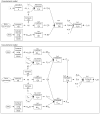
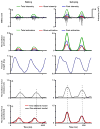
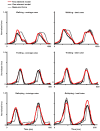
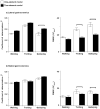
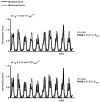
Similar articles
-
Validation of Hill-type muscle models in relation to neuromuscular recruitment and force-velocity properties: predicting patterns of in vivo muscle force.Integr Comp Biol. 2014 Dec;54(6):1072-83. doi: 10.1093/icb/icu070. Epub 2014 Jun 12. Integr Comp Biol. 2014. PMID: 24928073 Free PMC article. Review.
-
Recruitment of faster motor units is associated with greater rates of fascicle strain and rapid changes in muscle force during locomotion.J Exp Biol. 2013 Jan 15;216(Pt 2):198-207. doi: 10.1242/jeb.072637. Epub 2012 Sep 12. J Exp Biol. 2013. PMID: 22972893 Free PMC article.
-
Comparison of human gastrocnemius forces predicted by Hill-type muscle models and estimated from ultrasound images.J Exp Biol. 2017 May 1;220(Pt 9):1643-1653. doi: 10.1242/jeb.154807. Epub 2017 Feb 15. J Exp Biol. 2017. PMID: 28202584 Free PMC article.
-
Force from cat soleus muscle during imposed locomotor-like movements: experimental data versus Hill-type model predictions.J Neurophysiol. 1997 Mar;77(3):1538-52. doi: 10.1152/jn.1997.77.3.1538. J Neurophysiol. 1997. PMID: 9084618
-
Contributions to the understanding of gait control.Dan Med J. 2014 Apr;61(4):B4823. Dan Med J. 2014. PMID: 24814597 Review.
Cited by
-
Smart ECG Biosensor Design with an Improved ANN Performance Based on the Taguchi Optimizer.Bioengineering (Basel). 2022 Sep 19;9(9):482. doi: 10.3390/bioengineering9090482. Bioengineering (Basel). 2022. PMID: 36135028 Free PMC article.
-
Metabolic cost underlies task-dependent variations in motor unit recruitment.J R Soc Interface. 2018 Nov 21;15(148):20180541. doi: 10.1098/rsif.2018.0541. J R Soc Interface. 2018. PMID: 30464057 Free PMC article.
-
The impact of intrinsic muscle properties on simulated reaching performance.Comput Methods Biomech Biomed Engin. 2023 May;26(7):777-788. doi: 10.1080/10255842.2022.2089022. Epub 2022 Jun 30. Comput Methods Biomech Biomed Engin. 2023. PMID: 35770821 Free PMC article.
-
Geometric models to explore mechanisms of dynamic shape change in skeletal muscle.R Soc Open Sci. 2018 May 16;5(5):172371. doi: 10.1098/rsos.172371. eCollection 2018 May. R Soc Open Sci. 2018. PMID: 29892420 Free PMC article.
-
Size, History-Dependent, Activation and Three-Dimensional Effects on the Work and Power Produced During Cyclic Muscle Contractions.Integr Comp Biol. 2018 Aug 1;58(2):232-250. doi: 10.1093/icb/icy021. Integr Comp Biol. 2018. PMID: 29726964 Free PMC article.
References
-
- Biewener A, Baudinette R. In vivo muscle force and elastic energy storage during steady-speed hopping of tammar wallabies (Macropus eugenii) Journal of Experimental Biology. 1995;198:1829–41. - PubMed
-
- Bol M, Sturmat M, Weichert C, Kober C. A new approach for the validation of skeletal muscle modeling using MRI data. Computer Mech. 2011;47:591–601.
-
- Brown IE, Cheng EJ, Loeb GE. Measured and modeled properties of mammalian skeletal muscle. II. The effects of stimulus frequency on force-length and force-velocity relationships. Journal of Muscle Research and Cell Motility. 1999;20:627–643. - PubMed
-
- Brown IE, Loeb GE. Measured and modeled properties of mammalian skeletal muscle: IV. Dynamics of activation and deactivation. Journal of Muscle Research and Cell Motility. 2000;21:33–47. - PubMed
Publication types
MeSH terms
Grants and funding
LinkOut - more resources
Full Text Sources
Other Literature Sources

